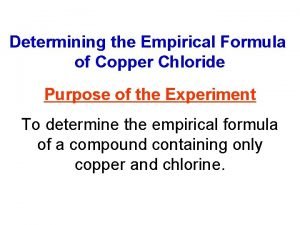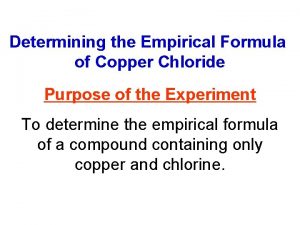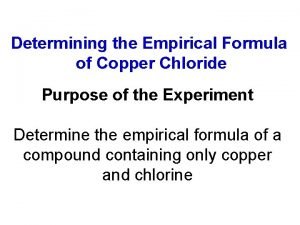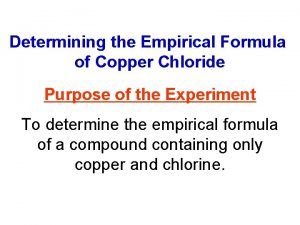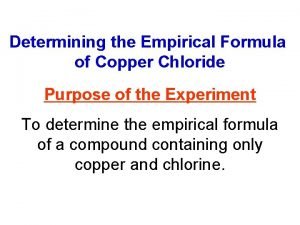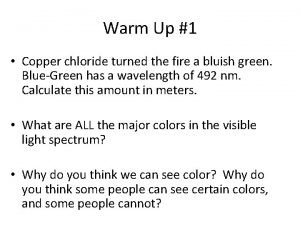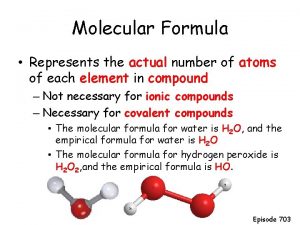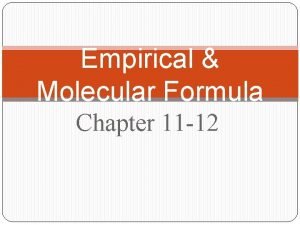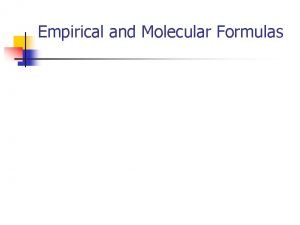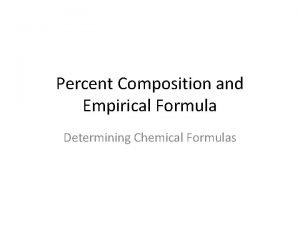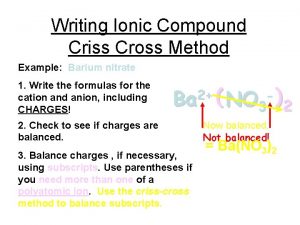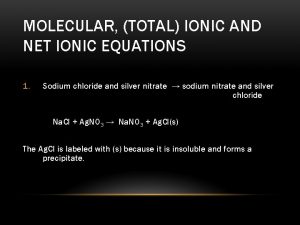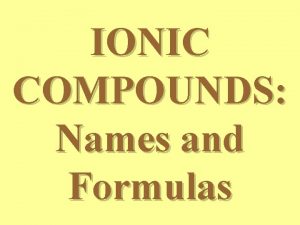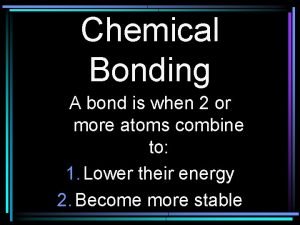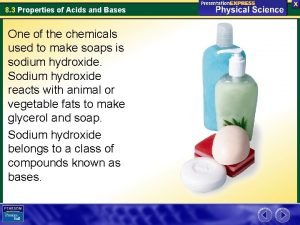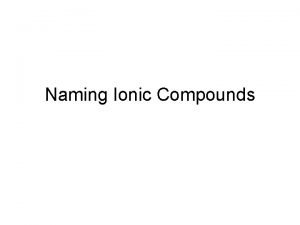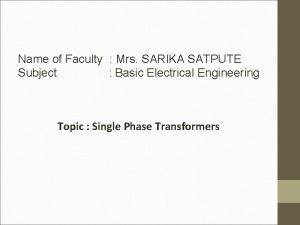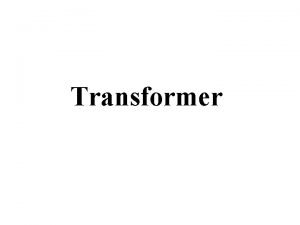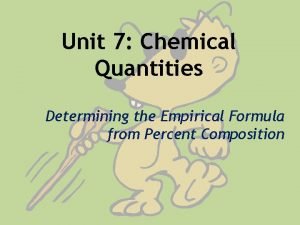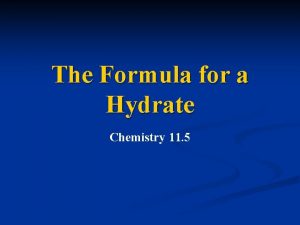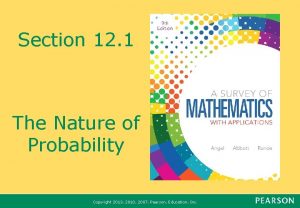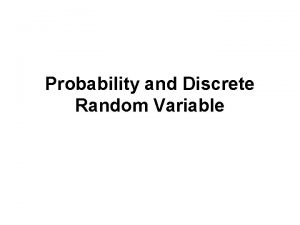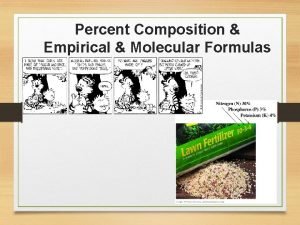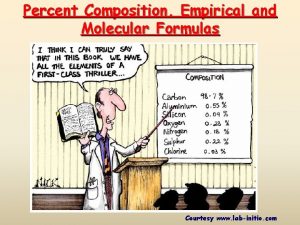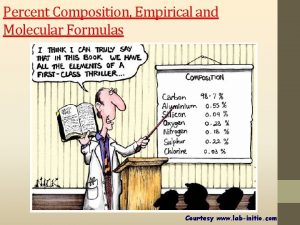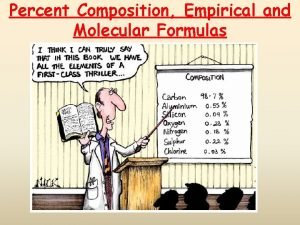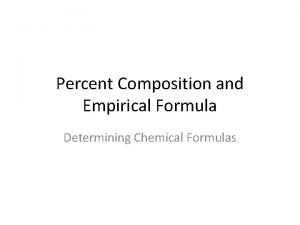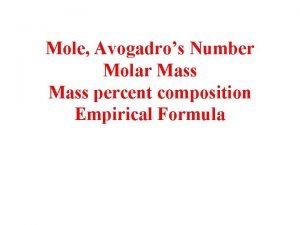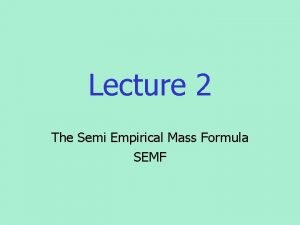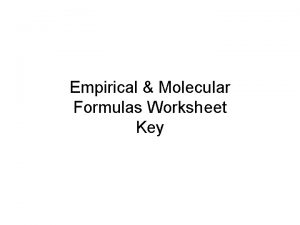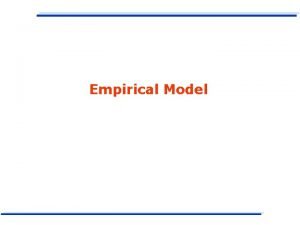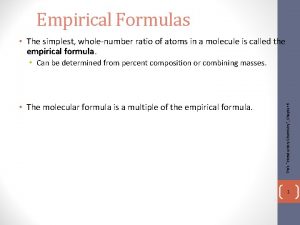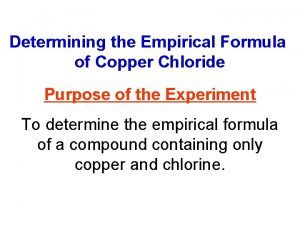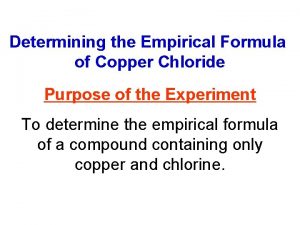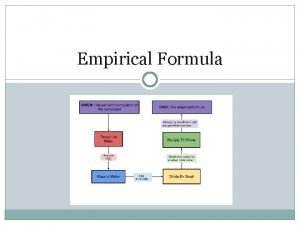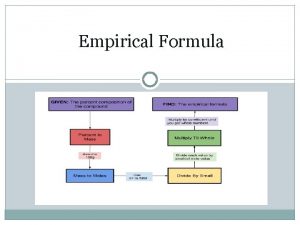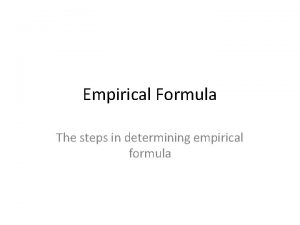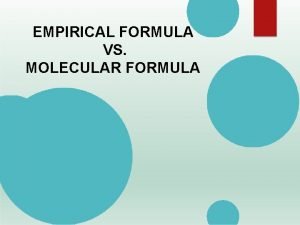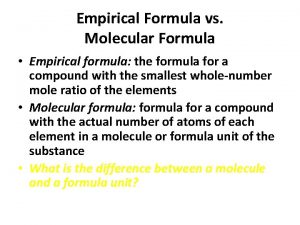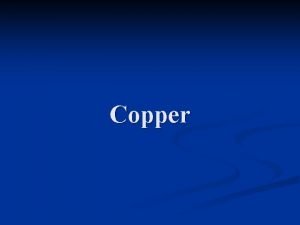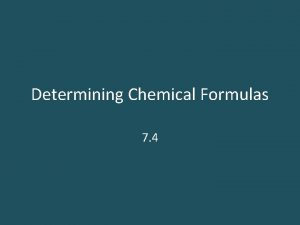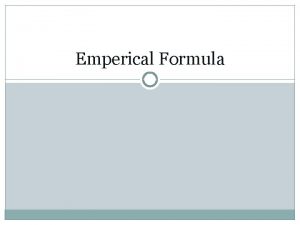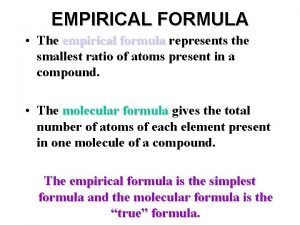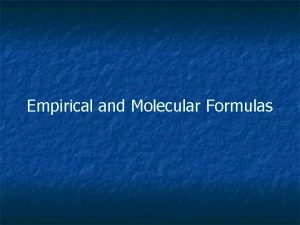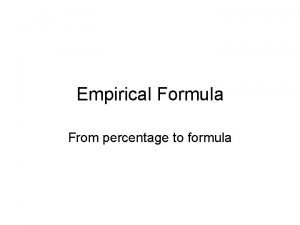Determining the Empirical Formula of Copper Chloride Purpose































![Copper is a Transition Metal. Ground state electron configuration: [Ar]. 3 d 10. 4 Copper is a Transition Metal. Ground state electron configuration: [Ar]. 3 d 10. 4](https://slidetodoc.com/presentation_image_h2/445e21c32960dad1655df67205da4c0c/image-32.jpg)










- Slides: 42

Determining the Empirical Formula of Copper Chloride Purpose of the Experiment To determine the empirical formula of a compound containing only copper and chlorine.

Molar Mass (Molecular Weight) The mass in grams of 1 mole of a compound is equal to the mass in grams of the components. H 2 O MW = 2(1. 008) + 15. 999 g Al. Cl 3 MW = 26. 98 + 3(35. 45) g (Note: The Significant Figures. ) So the mass in grams of 1 mole of each compound is…

Molar Mass (Molecular Weight) The mass in grams of 1 mole of each compound is… H 2 O MW = 18. 015 g Al. Cl 3 MW= 133. 33 g

Percent Composition Defn: The percentages of a compound’s mass that are due to each of the component elements. Mass of C = 2 x 12. 011 g Mass of H = 6 x 1. 008 g Mass of O = 1 x 15. 999 g C 2 H 5 OH Mass of 1 mole of C 2 H 5 OH = ? ?

Percent Composition Defn: The percentages of a compound’s mass that are due to each of the component elements. Mass of C = 24. 022 g Mass of H = 6. 048 g Mass of O = 15. 999 g C 2 H 5 OH Mass of 1 mole of C 2 H 5 OH = 24. 022 + 6. 048 + 15. 999 = 46. 069 g Mass percent of C = ? ?

Percent Composition Defn: The percentages of a compound’s mass that are due to each of the component elements. Mass of C = 24. 022 g Mass of H = 6. 048 g Mass of O = 15. 999 g C 2 H 5 OH Mass of 1 mole of C 2 H 5 OH = 24. 022 + 6. 048 + 15. 999 = 46. 069 g

Empirical Formula Represents the simplest whole-number ratio of the various types of atoms in a compound. Examples What is the Empirical Formula for the following compounds? Drying Agent Isoamyl Acetate Scent of Bananas P 4 O 10 C 14 H 28 O 4 Caffeine C 8 H 10 N 4 O 2

Empirical Formula Represents the simplest whole-number ratio of the various types of atoms in a compound. Examples What is the Empirical Formula for the following compounds? Drying Agent Isoamyl Acetate Scent of Bananas P 4 O 10 C 14 H 28 O 4 C 8 H 10 N 4 O 2 P 2 O 5 C 7 H 14 O 2 C 4 H 5 N 2 O Caffeine

Empirical Formula Example 1 A white compound is analyzed and found to contain 43. 64% phosphorous and 56. 36% oxygen by mass. What is the empirical formula? 1 st Step:

Empirical Formula Example 1 A white compound is analyzed and found to contain 43. 64% phosphorous and 56. 36% oxygen by mass. What is the empirical formula? 1 st Step: Because it is a percent we can choose any mass we want and multiply that mass by the percents of the components. What is the easiest mass to choose?

Empirical Formula Example 1 A white compound is analyzed and found to contain 43. 64% phosphorous and 56. 36% oxygen by mass. What is the empirical formula? 1 st Step: Because it is a percent we can choose any mass we want and multiply that mass by the percents of the components. What is the easiest mass to choose? 100. 00 grams

Empirical Formula Example 1 A white compound is analyzed and found to contain 43. 64% phosphorous and 56. 36% oxygen by mass. So since we chose 100. 00 g of compound we have 43. 64 g P & 56. 36 g O. Can we compare grams directly? 2 nd Step:

Empirical Formula Example 1 A white compound is analyzed and found to contain 43. 64% phosphorous and 56. 36% oxygen by mass. So since we chose 100. 00 g of compound we have 43. 64 g P & 56. 36 g O. Can we compare grams directly? 2 nd Step: Convert grams to moles. 43. 64 g P x ? ? ? 56. 36 g O x ? ? ?

Empirical Formula Example 1 A white compound is analyzed and found to contain 43. 64% phosphorous and 56. 36% oxygen by mass. So since we chose 100. 00 g of compound we have 43. 64 g P & 56. 36 g O. Can we compare grams directly? 2 nd Step: Convert grams to moles. 43. 64 g P x (1 mol P / 30. 974 g P) = 1. 409 mol P 56. 36 g O x (1 mol O / 15. 999 g O) = 3. 523 mol O

Empirical Formula Example 1 A white compound is analyzed and found to contain 43. 64% phosphorous and 56. 36% oxygen by mass. So we now have 1. 409 moles of P & 3. 523 moles of O. What can we do to compare the moles? 3 rd Step:

Empirical Formula Example 1 A white compound is analyzed and found to contain 43. 64% phosphorous and 56. 36% oxygen by mass. So we now have 1. 409 moles of P & 3. 523 moles of O. What can we do to compare the moles? 3 rd Step: Convert the smaller number to one. Do this by dividing both mole values by the smaller one. 1. 409 = ? P and 1. 409 3. 523 =? O 1. 409

Empirical Formula Example 1 A white compound is analyzed and found to contain 43. 64% phosphorous and 56. 36% oxygen by mass. So we now have 1. 409 moles of P & 3. 523 moles of O. What can we do to compare the moles? 3 rd Step: Convert the smaller number to one. Do this by dividing both mole values by the smaller one. 1. 409 = 1 P and 1. 409 3. 523 = 2. 5 O 1. 409

Empirical Formula Example 1 A white compound is analyzed and found to contain 43. 64% phosphorous and 56. 36% oxygen by mass. So by dividing both mole values by the smaller one we deduced: 1. 409 = 1 P and 1. 409 3. 523 = 2. 5 O 1. 409 This yields the formula PO 2. 5 Is this an acceptable empirical formula?

Empirical Formula Example 1 A white compound is analyzed and found to contain 43. 64% phosphorous and 56. 36% oxygen by mass. So by dividing both mole values by the smaller one we deduced: 1. 409 = 1 P and 1. 409 3. 523 = 2. 5 O 1. 409 This yields the formula PO 2. 5 Is this an acceptable empirical formula? No.

Empirical Formula Example 1 A white compound is analyzed and found to contain 43. 64% phosphorous and 56. 36% oxygen by mass. Since compounds must contain whole numbers of atoms, the empirical formula should contain only whole numbers. What must we do to fix the formula PO 2. 5?

Empirical Formula Example 1 A white compound is analyzed and found to contain 43. 64% phosphorous and 56. 36% oxygen by mass. Since compounds must contain whole numbers of atoms, the empirical formula should contain only whole numbers. What must we do to fix the formula PO 2. 5? 4 th Step: Convert to whole numbers. Do this by multiplying both mole values to get whole numbers.

Empirical Formula Example 1 A white compound is analyzed and found to contain 43. 64% phosphorous and 56. 36% oxygen by mass. Since compounds must contain whole numbers of atoms, the empirical formula should contain only whole numbers. What must we do to fix the formula PO 2. 5? 4 th Step: Convert to whole numbers. Do this by multiplying both mole values to get whole numbers. 1 Px 2=2 P 2. 5 O x 2 = 5 O Empirical Formula = P 2 O 5

Empirical Formula Example 2 A student burns 0. 353 g of magnesium ribbon in an open crucible. A white powder forms and is found to weigh 0. 585 g. What is the empirical formula? Atmospheric oxygen is in excess heat Mg (solid – silvery white) + O 2 (gas) → Mgx. Oy (solid – white) (0. 353 g) limiting reagent (0. 585 g) resulting mass How do we determine the empirical formula?

Empirical Formula Example 2 A student burns 0. 353 g of magnesium ribbon in an open crucible. A white powder forms and is found to weigh 0. 585 g. What is the empirical formula? Atmospheric oxygen is in excess heat Mg (solid – silvery white) + O 2 (gas) → Mgx. Oy (solid – white) (0. 353 g) limiting reagent (0. 585 g) resulting mass How do we determine the empirical formula? 1 st Step: Calculate mass percents.

Empirical Formula Example 2 1 st Step: Calculate mass percents. Mass of O = total mass of compound – mass of Mg = 0. 232 g Mg = 60. 3% and O = 39. 7%

Empirical Formula Example 2 2 nd Step: Formula Masses and their Percent Composition. Formula masses and percent composition of three theoretical compounds of Mg and O Mg = 24. 31 g/mole O = 15. 999 g/mole Formula of Oxide Mgx. Oy Formula Weight Mg. O 24. 31+15. 999 = Mg. O 2 24. 31 + 2(15. 999) = Mg 2 O 2(24. 31) + 15. 999 = Mg = 60. 3% and %Mg O = 39. 7% %O

Empirical Formula Example 2 2 nd Step: Formula Masses and their Percent Composition. Formula masses and percent composition of three theoretical compounds of Mg and O Mg = 24. 31 g/mole O = 15. 999 g/mole Formula of Oxide Mgx. Oy Formula Weight Mg. O 24. 31+15. 999 = 40. 309 Mg. O 2 24. 31 + 2(15. 999) = 56. 308 Mg 2 O 2(24. 31) + 15. 999 = 64. 619 Mg = 60. 3% and %Mg O = 39. 7% %O

Empirical Formula Example 2 2 nd Step: Formula Masses and their Percent Composition. Formula masses and percent composition of three theoretical compounds of Mg and O Mg = 24. 31 g/mole Formula of Oxide Mgx. Oy Mg. O 2 Mg 2 O O = 15. 999 g/mole Formula Weight %Mg %O 24. 31+15. 999 = 40. 309 24. 31/ 40. 309 15. 999/ 40. 309 56. 308 24. 31/ 56. 308 2 x 15. 999/ 56. 308 64. 619 2 x 24. 31/ 64. 619 15. 999/ 64. 619 24. 31 + 2(15. 999) = 2(24. 31) + 15. 999 = Mg = 60. 3% and O = 39. 7%

Empirical Formula Example 2 2 nd Step: Formula Masses and their Percent Composition. Formula masses and percent composition of three theoretical compounds of Mg and O Mg = 24. 31 g/mole O = 15. 999 g/mole Formula of Oxide Mgx. Oy Formula Weight %Mg %O Mg. O 24. 31+15. 999 = 40. 309 60. 3 39. 7 Mg. O 2 24. 31 + 2(15. 999) = 56. 308 43. 2 56. 8 Mg 2 O 2(24. 31) + 15. 999 = 64. 619 75. 2 24. 8 Mg = 60. 3% and O = 39. 7%

Empirical Formula Example 2 2 nd Step: Formula Masses and their Percent Composition. Formula masses and percent composition of three theoretical compounds of Mg and O Mg = 24. 31 g/mole O = 15. 999 g/mole Formula of Oxide Mgx. Oy Formula Weight %Mg %O **Mg. O 24. 31+15. 999 = 40. 309 60. 3 39. 7 Mg. O 2 24. 31 + 2(15. 999) = 56. 308 43. 2 56. 8 Mg 2 O 2(24. 31) + 15. 999 = 64. 619 75. 2 24. 8 Mg = 60. 3% and O = 39. 7%

Today’s Experiment Al(s) + Cux. Cly(aq) (silvery white) (excess) (blue soln) known mass of ~25 ml Limiting reagent Al. Cl 3(aq) + Cu(s) (gray soln) (reddish) known mass of product
![Copper is a Transition Metal Ground state electron configuration Ar 3 d 10 4 Copper is a Transition Metal. Ground state electron configuration: [Ar]. 3 d 10. 4](https://slidetodoc.com/presentation_image_h2/445e21c32960dad1655df67205da4c0c/image-32.jpg)
Copper is a Transition Metal. Ground state electron configuration: [Ar]. 3 d 10. 4 s 1 Shell structure: 2. 8. 1 Transition metals may exhibit multiple oxidation states (+1, +2, +3, etc…). These are not easily predicted by position in the periodic table. Transition metal ions in aqueous solutions are frequently brightly colored, this is also due to transitions of electrons in the d orbitals (e. g. Cu ions tend to be blue).

Last time we worked with Zinc. Zn and Al are both stronger reducing agents than copper. (Note the redox potentials on next slide. ) Because of this either one would work to produce metallic copper from a solution of a copper salt. We chose aluminum to work with because the reaction between Zinc and Copper Chloride is quite exothermic and extreme caution would have had to have been observed to avoid burns.

The oxidation of aluminum is more likely than the oxidation of zinc. * * * These potentials indicate the relative thermodynamic tendency for the indicated half-reaction to occur. Al <--> Al+3 + 3 e– Zn <--> Zn+2 + 2 e– Cu <--> Cu+2 + 2 e– E = -1. 66 volts E = -0. 763 volts E = +0. 34 volts

Removal of Excess Reducing Agent 2 Al(s) + 6 HCl(aq) --> 2 Al. Cl 3(aq) + 3 H 2(g) Cu(s) + n HCl(aq) -x-> No Reaction Once you have ensured that the aluminum is in excess (some aluminum will be floating on the surface), then it is time to proceed with the next step: removal of the aluminum. This is accomplished by adding HCl in excess. The HCl reacts with the aluminum and not the copper.

Checkout 3 pc Al foil – Add small pieces. Do not fold. Add in excess. If there is any remaining unused Al, give to TA. 1 - pair of Beaker Tongs Return to stockroom when you are done. Reagents in Lab Cux. Cly solution in 4 L spigot jugs - Take ~25 ml for each run (using 100 ml Grad Cylinder) Record data: (0. 08067 g Cux. Cly /ml, d=1. 074 g/ml) 10% HCl in 1 L wash bottles - Take 5 -10 ml for each run (using 10 ml Grad Cylinder) (N. B. solid Na. HCO 3 is to be used for acid spills. )

Flow Chart for Procedure Casserole 1 – Weigh to the nearest 0. 001 g. Record mass [3]. 100 ml Graduated Cylinder Acquire ~25 ml Cux. Cly solution. Pour Cux. Cly soln into casserole Casserole 1 with ~25 ml Cux. Cly soln – Weigh to the nearest 0. 001 g. Record mass [4]. Casserole 1 with ~25 ml Cux. Cly soln Obtain Al foil. Tear Al foil into ~1 cm 2 pieces. Add Al foil to Cux. Cly soln. Submerge foil with glass stirring rod. Do NOT stir. When solution turns green – start adding ~1/4 cm 2 pieces. When solution is grey stop. Are there small pieces of Al floating on the surface? No. Add more Al. Yes. Decant Al. Cl 3 soln into waste beaker.

Flow Chart for Procedure Yes. Decant Al. Cl 3 soln into waste beaker. Obtain ~10 ml of HCl. Casserole 1 with solid Cu. Beaker 1 - Have TA verify that all Cu has been removed from solution. Yes. Pour HCl over Cu in casserole. Stir gently. Are there small pieces of Al visible on the surface? Are there bubbles still forming on the surface? Yes. Pour in proper waste container. No. Add more Al. No. Add more HCl. Decant Al. Cl 3 soln into waste beaker. Rinse twice with distilled water. Decant rinsings into waste beaker. Casserole 1 with damp solid Cu. Beaker 1 with waste Al. Cl 3 solution. Pour in proper waste container.

Flow Chart for Procedure Casserole 1 with damp solid Cu. Place on hotplate (~100 o. C) for 5 min. * Take off hotplate. Cool to room temp. Weigh to the nearest 0. 001 g. Record mass [8] under 1 st heating. *Repeat until 2 successive readings are within 0. 010 g. (Note: Decrease heating time each successive heating and break apart solid each time with a microspatula to increase surface area. ) Is the mass within 0. 010 g of the previous mass? No. Continue with next heating. Yes. Stop. Pour solid Cu into “used solids” container.

Highlights of Procedure Notes v. Record all weights to 0. 001 g. v. Weigh ~25 ml of Cux. Cly solution, use exact density to calculate exact volume, then calculate the mass of Cux. Cly. v. Do not use the metal microspatulas when stirring solution. v. Add Al foil until blue color is gone, allow excess foil to dissolve also. v. Allow container to cool before weighing. v. Speed up cooling by placing under hoods. v. Break apart solid Cu between weighing with microspatula.

Hazards v 10% HCl - strong acid, corrosive v. Cux. Cly solution - heavy metal, irritant v. Hot surfaces - hotplates, glassware (Be Careful: Hot glassware looks just like cold glassware. ) Waste v. Liquid Waste: Al+3 / HCl v. Used Solids: Cu

Homework Assignment – Due Feb. 6 -9 Read: Dimensional Analysis (pp. 24 -28) Do: Problem Set #2 (p. 25) 2. 1 -2. 4 & Set #3 (28) 3. 1 -3. 2 (On a separate sheet of paper, show your calculations. ) For Feb. 6 -9 Read: Ternary Mixture pp 95 -111. Turn-In: EF pp. 87 -93; Calculations Page (explained on p. 87*) & DA Homework. *Note that on the bottom of page 87 it states that the calculations which need to be shown on a separate sheet of paper are indicated by asterisks (*).
 Copper chloride electron configuration
Copper chloride electron configuration Empirical formula of copper chloride
Empirical formula of copper chloride Empirical formula of copper chloride lab
Empirical formula of copper chloride lab Magnesium ribbon formula
Magnesium ribbon formula Copper chloride formula
Copper chloride formula Frequency and wavelength relationship
Frequency and wavelength relationship Fact claim examples
Fact claim examples Empirical formula vs molecular formula
Empirical formula vs molecular formula Molecular mass of potassium permanganate
Molecular mass of potassium permanganate Empirical formula
Empirical formula Which formula is an empirical formula?
Which formula is an empirical formula? Find empirical formula
Find empirical formula Molecular formula = n × empirical formula
Molecular formula = n × empirical formula Empirical formula and molecular formula pogil
Empirical formula and molecular formula pogil Empirical formula to molecular formula
Empirical formula to molecular formula Empirical formula of c5h12
Empirical formula of c5h12 Mass practice problems
Mass practice problems Barium nitrate formula criss cross method
Barium nitrate formula criss cross method Copper(ii) nitrate and sodium sulfide
Copper(ii) nitrate and sodium sulfide Lithium chloride formula of ionic compound
Lithium chloride formula of ionic compound The correct electron dot formula for hydrogen chloride is
The correct electron dot formula for hydrogen chloride is Potassium chloride formula
Potassium chloride formula Stock system naming
Stock system naming Voltage regulation definition
Voltage regulation definition Copper loss in transformer formula
Copper loss in transformer formula Introduction to transformer
Introduction to transformer Empirical formula poem
Empirical formula poem Hydrate chemistry formula
Hydrate chemistry formula Empirical probability formula
Empirical probability formula Empirical probability definition
Empirical probability definition Empirical formula from percent composition
Empirical formula from percent composition Empirical formula of lactic acid
Empirical formula of lactic acid Empirical formula from percent composition
Empirical formula from percent composition Empirical formula from percent composition
Empirical formula from percent composition Adipic acid empirical formula
Adipic acid empirical formula Empirical formula to percent composition
Empirical formula to percent composition How to find empirical formula with percentages
How to find empirical formula with percentages Empirical formula rhyme
Empirical formula rhyme Avogadros number units
Avogadros number units Semi empirical mass formula notes
Semi empirical mass formula notes Empirical and molecular formula worksheet
Empirical and molecular formula worksheet Example of empirical model
Example of empirical model Glyceraldehyde empirical formula
Glyceraldehyde empirical formula
